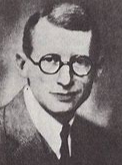万物简史(MP3+中英字幕) 第628期:神秘的两足动物(6)
日期:2019-10-28 09:59
(单词翻译:单击)
Broom was an accomplished paleontologist, and since he was also resident in South Africa he was able to examine the Taung skull at first hand. He could see at once that it was as important as Dart supposed and spoke out vigorously on Dart's behalf, but to no effect. For the next fifty years the received wisdom was that the Taung child was an ape and nothing more. Most textbooks didn't even mention it. Dart spent five years working up a monograph, but could find no one to publish it. Eventually he gave up the quest to publish altogether (though he did continue hunting for fossils). For years, the skull—today recognized as one of the supreme treasures of anthropology—sat as a paperweight on a colleague's desk.
布罗姆是一个颇有造诣的古生物学家,又居住在南非,因此有机会亲自审视塔翁头骨。他立刻意识到它确实具有达特所认为的那种重要意义,并不遗余力地为达特辩护,可是毫无效果。在以后的50年里,人们一致的看法是塔翁男孩只不过是猿,仅此而已。大多数教科书甚至都没有提到它。达特用5年时间撰写了一篇论文,却找不到发表的地方。最后他彻底放弃了寻求发表的努力(虽然他还在继续寻找化石)。这块头骨——今天被认为是人类学最珍贵的东西之一——在达特一位同事的办公桌上被当做镇纸用了好多年。
At the time Dart made his announcement in 1924, only four categories of ancient hominid were known—Homo heidelbergensis, Homo rhodesiensis, Neandertals, and Dubois's Java Man—but all that was about to change in a very big way.
先是在中国,一位名叫戴维森·步达生的加拿大业余考古爱好者开始在一处名为龙骨山的地方进行挖掘工作。这座小山在当地无人不知,因为人们在那里发现了古化石。不幸的是,当地人并没有把这些化石保存下来供科学研究用,却把它们磨成粉当成了一种制药材料。我们不知道有多少无价的直立人化石被当地人当做制作中药材的材料。当步达生来到那里的时候,那个地方已经被挖得不成样子,但是他还是发现了一颗臼齿化石。据此他很英明地得出结论,他发现了一种新的化石人类型:北京中国猿人,很快他就被称为北京人。
布罗姆是一个颇有造诣的古生物学家,又居住在南非,因此有机会亲自审视塔翁头骨。他立刻意识到它确实具有达特所认为的那种重要意义,并不遗余力地为达特辩护,可是毫无效果。在以后的50年里,人们一致的看法是塔翁男孩只不过是猿,仅此而已。大多数教科书甚至都没有提到它。达特用5年时间撰写了一篇论文,却找不到发表的地方。最后他彻底放弃了寻求发表的努力(虽然他还在继续寻找化石)。这块头骨——今天被认为是人类学最珍贵的东西之一——在达特一位同事的办公桌上被当做镇纸用了好多年。
At the time Dart made his announcement in 1924, only four categories of ancient hominid were known—Homo heidelbergensis, Homo rhodesiensis, Neandertals, and Dubois's Java Man—but all that was about to change in a very big way.
1924年,当达特公布他的发现的时候,人们已知的古人类只有4种:海德尔堡人、罗德西亚人、尼安德特人,以及杜布瓦的爪哇人——但是很快,这一切就将发生根本性改观。

戴维森·步达生
先是在中国,一位名叫戴维森·步达生的加拿大业余考古爱好者开始在一处名为龙骨山的地方进行挖掘工作。这座小山在当地无人不知,因为人们在那里发现了古化石。不幸的是,当地人并没有把这些化石保存下来供科学研究用,却把它们磨成粉当成了一种制药材料。我们不知道有多少无价的直立人化石被当地人当做制作中药材的材料。当步达生来到那里的时候,那个地方已经被挖得不成样子,但是他还是发现了一颗臼齿化石。据此他很英明地得出结论,他发现了一种新的化石人类型:北京中国猿人,很快他就被称为北京人。


